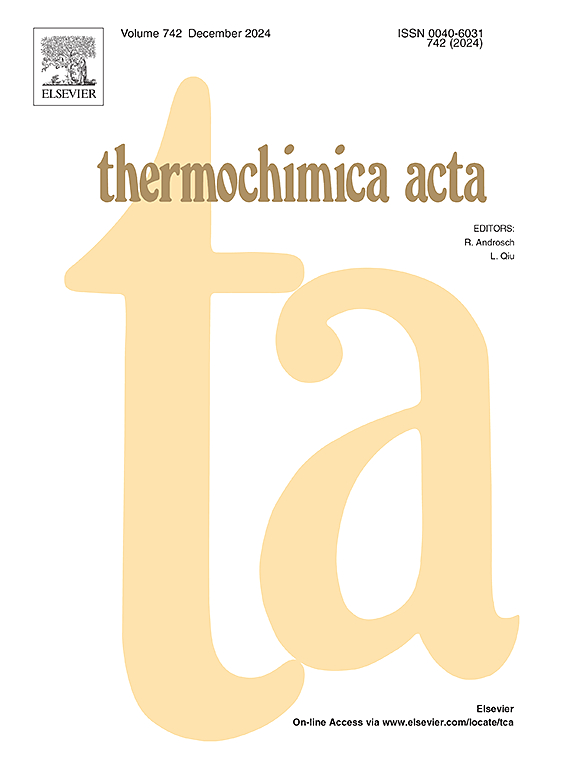快速扫描芯片量热计加热扫描非结晶脂肪族聚酰胺时氢键密度控制的亚tg退火峰
IF 3.1
2区 化学
Q2 CHEMISTRY, ANALYTICAL
引用次数: 0
摘要
采用快速扫描芯片量热法(FSC),对一系列脂肪族聚酰胺(PAs),包括pa6, pa6.6, pa6.10, pa6.12, pa11和pa12进行了物理老化,并分析了在低于玻璃化转变温度(Tg)的50至100 K退火过程中长达数小时的结构变化。在如此低的温度下退火非结晶样品的非晶玻璃,在随后记录的FSC加热扫描中,在稍高的温度下产生吸热的亚tg退火峰,在给定的退火温度下,随着退火时间的增加,面积成比例。退火温度的变化进一步表明,随着退火温度的降低,潜在的结构变化过程减慢,但即使在Tg低于100 K时也不会消失。最重要的是,对所研究的各种PAs的行为进行比较,揭示了化学结构的明显影响,即在预定义的时间内,结构重组(玻璃弛豫和/或有序)的数量随着酰胺基团之间亚甲基序列长度的减少而减少。研究表明,链上酰胺基团的浓度决定了与相邻分子段的氢键网络的密度,控制/限制了亚纳米大小的分子单元的重排。本文章由计算机程序翻译,如有差异,请以英文原文为准。

Hydrogen-bond density controlled sub-Tg annealing peaks in fast-scanning-chip calorimeter heating scans of non-crystallized aliphatic polyamides
A series of aliphatic polyamides (PAs) including PA 6, PA 6.6, PA 6.10, PA 6.12, PA 11, and PA 12 has been subjected to physical aging and analyzed regarding changes of structure during annealing at temperatures around 50 to 100 K below the glass transition temperature () for periods up to few hours, employing fast scanning chip calorimetry (FSC). Annealing the amorphous glass of non-crystallized samples at such low temperatures produces endothermic sub- annealing peaks at slightly higher temperature in subsequently recorded FSC heating scans, scaling in area with the time of annealing for a given annealing temperature. Variation of the annealing temperature furthermore indicates that the underlying process of structure-change slows down with decreasing annealing temperature but not disappears even 100 K below . Most important, comparison of the behavior of the various PAs investigated reveals a distinct effect of the chemical structure such that the amount of structure-reorganization (glass relaxation and/or ordering) in a pre-defined period of time reduces with decreasing methylene-group sequence-length between amide groups. It appears that the amide-group concentration in the chains, which determines the density of the hydrogen-bond network to neighbored molecular segments, controls/restricts the re-arrangements of sub-nm sized molecular units.
求助全文
通过发布文献求助,成功后即可免费获取论文全文。
去求助
来源期刊

Thermochimica Acta
化学-分析化学
CiteScore
6.50
自引率
8.60%
发文量
210
审稿时长
40 days
期刊介绍:
Thermochimica Acta publishes original research contributions covering all aspects of thermoanalytical and calorimetric methods and their application to experimental chemistry, physics, biology and engineering. The journal aims to span the whole range from fundamental research to practical application.
The journal focuses on the research that advances physical and analytical science of thermal phenomena. Therefore, the manuscripts are expected to provide important insights into the thermal phenomena studied or to propose significant improvements of analytical or computational techniques employed in thermal studies. Manuscripts that report the results of routine thermal measurements are not suitable for publication in Thermochimica Acta.
The journal particularly welcomes papers from newly emerging areas as well as from the traditional strength areas:
- New and improved instrumentation and methods
- Thermal properties and behavior of materials
- Kinetics of thermally stimulated processes
 求助内容:
求助内容: 应助结果提醒方式:
应助结果提醒方式:


